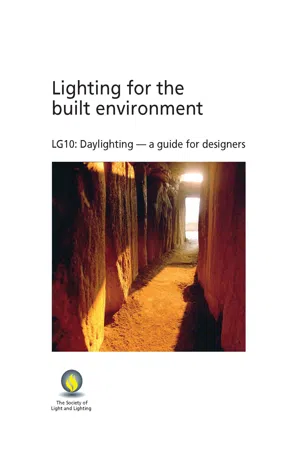
Lighting Guide 10: Daylighting - a guide for designers
- English
- PDF
- Available on iOS & Android
Lighting Guide 10: Daylighting - a guide for designers
About this book
Throughout history, daylight has been a crucial factor in the design of buildings. Before the advent of artificial light (from oil lamps, gas lamps and later electricity), it was necessary to design buildings so that their occupants could make maximum use of available daylight. As a result building plans were narrow and window sizes large. Cheap electric light appeared to remove these constraints, allowing windows to be driven more by aesthetics than physical need, and plan depths to be increased to reduce overall building costs. We now know that this approach overlooked the vital importance of daylight's contribution to human comfort and satisfaction in indoor environments. Since the turn of the century, we have discovered evidence of the presence of a non-visual photoreceptor in the human eye, whose primary purpose is to regulate the body's internal clock and begun to model the behaviour of these receptors in human biology. In short, we are now beginning to understand the importance of exposure to adequate daylight levels for the health and wellbeing of humans, many of whom now spend most of their lives inside buildings.The purpose of this document is to guide the reader through the process of designing a building that is well daylit. Daylighting is a design process that needs to be rooted in both aesthetics and physics — art and science. As such, it is notoriously difficult to completely define a well-daylit building.
Frequently asked questions
- Essential is ideal for learners and professionals who enjoy exploring a wide range of subjects. Access the Essential Library with 800,000+ trusted titles and best-sellers across business, personal growth, and the humanities. Includes unlimited reading time and Standard Read Aloud voice.
- Complete: Perfect for advanced learners and researchers needing full, unrestricted access. Unlock 1.4M+ books across hundreds of subjects, including academic and specialized titles. The Complete Plan also includes advanced features like Premium Read Aloud and Research Assistant.
Please note we cannot support devices running on iOS 13 and Android 7 or earlier. Learn more about using the app.
Information
Table of contents
- Lighting Guide 10: Daylighting - a guide for designers: Lighting for the built environment OFC
- Foreword
- Preface
- Contents
- Introduction
- 1 Daylighting: an overview
- 2 Initial design considerations
- 3 Detailed design considerations
- 4 Visualisation
- Appendices
- References
- Further reading
- Glossary
- Index